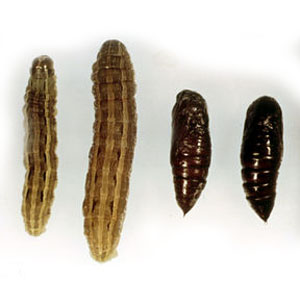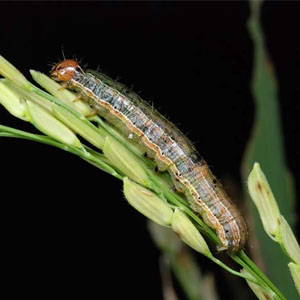Common Pest & Diseases In Crops And Their Management
Bacterial leaf Blight



Symptoms:
- Lesions starts from the tip of the leaf and extend downwards along the margin of leaf blade to form linear white stripes.
- Lesions appear to be wavy in nature.
- Kresek phase appears one or two weeks after transplanting results in partial withering of plants.
Solutions:
- Grow Bacterial leaf blight tollerant rice varieties like IR50, IR36, IR20, Prasad, Manoharsali etc.
- Stop topdressing of nitrogenous fertilizer, instead topdress potash @ 20 kg per ha.
- Spray cow dung solution (2 kg fresh cow dung in 10 ltr water).
Yellow Stem Borer



Symptoms:
- Formation of Deat Heart
- Formation of White Ear Head
- Exit holes can be seen in the stem.
Solutions:
- Your Installation of light traps in the central place of the field.
- Seedling root dip treatment with Chloropyriphos 20 EC @ 2.5 ml per liter of water for overnight.
- Release of Trichograma species @ 50,000 per ha at 30 days after transplanting.
- Spray Chloropyriphos 20 EC @ 2.5 ml per litre of water at 45 days after transplanting.
Leaf Folder



Symptoms:
- Damage appears as white feeding areas. Larvae infests the leaves by rolling the leaves longitudinally.
Solutions:
- Your Installation of light traps in the central place of the field. Seedling root dip treatment with Chloropyriphos 20 EC @ 2.5 ml per liter of water for overnight.
- Release of Trichograma species @ 50,000 per ha at 30 days after transplanting. Spray Chloropyriphos 20 EC @ 2.5 ml per litre of water at 45 days after transplanting.
Blast Disease of Rice



Symptoms:
- Leaf Blast-Spindle shaped spots in which center is grey and margin is brown
- Collar Blast-Brown lesion develop at the joining of leaf blade and leaf sheath results in grouping of the leaf blade.
- Nodal Blast-Nods of the stem turn black consequently all plant parts above the infected node dry up.
- Neck Blast-Neck of the penicle turns black and breaks at the neck.
Solutions:
- Growing tolerant variety like IR36, Ratna, Manoharsali, Pankaj.
- Stop top dressing of nitrogenous fertilizer instead apply aditional potashic fertilizer.
- Rice husk or rice straw compost application during puddling reduces disease severity.
- Spray Hinosan @ 1 ml/ltr or Bavistin 1 ml/ltr of water at first appearance of symptoms.
Nematode Infection



Symptoms:
- Roots develop nodules and plants become more susceptible to Soil borne diseases.
- Stunting of plants with yellowing of leaves.
- Nematode effected Rice fields shows the symptoms of gradual declination in plant height towards the centre of the field.
Solutions:
- Application of Neem Cake @ 250 kg/ha. Enrich compost with Trichoderma.
- Grow nematore resistant Varieties.
Fruit and Shoot Borer in Brinjal



Symptoms:
- In the early stages of the crop, caterpillars bore into young tender shoots, affected shoot becomes dry and drop off.
- At the later stage of the crop Caterpillars bore into flower bud, fruits and damage inside.
Solutions:
- Mechanical removal of damaged terminal parts and fruits and bury them in the soil.
- Carbofuran 3G @ 2. gm per plant at 20 days after transplanting.
- Growing garlic as inter-crop or border crop.
- Apply Deltarmethin (Decis 28EC) @ 1 ml/ltr or Malathion 50 EC @ 1.5 ml/ltr of water.
- Use of sex pheromone trap @ 30 nos./ha at 20-25 days after transplanting to till the harvest of the crop.
Bacterial Wilt of Solanaceous Crop (Brinjal, Tomato, Chilli)



Symptoms:
- Rapid and complete wilting of normal grown plants.
- Yellowish brown discolouration of vascular tissue.
- In later stage advantageous root formation.
- Infected plant when immersed in clean water bacterial ooze is visible in white strip.
Solutions:
- Growing of resistant varieties like Arka Abha, Avinash-II, All rounder etc.
- Crop rotation with Cow Pea, Maize, Cabbage etc.
- Seedling treatment with starptocycline @ 1 gm/40 ltr of water for 30 mins.
- Incorporation of lime 500 kg/ha and flooding the field 45 days before planting.
Late Blight in Potato



Symptoms:
- Brown, Purple or black spots may appear in Leaves, petiole or even on stem.
- In severe cases the fruit become leathery with dark brown spot.
Solutions:
- Growing of resistant varieties like Arka Abha, Avinash-II, All rounder etc.
- Treat seed tuber with Mencozeb @ 5gm/ltr of water for half an hour and dry the tubers in shed.
- Spray Mencozeb @ 2.5g and Ridomil MZ-72 @ 2gm per litre of water alternately at 10 days interval, starting from first fortnight of December.
Leaf Curl



Symptoms:
- Severe stunting of plants with downward rolling and crimpling of leaves.
- Newly emerged leaves exhibit slight yellow discolouration.
- Older leaves become leathery and brittle.
- Nones and internodes gets reduced in size.
- Infected plants become bushy in appearance and fruits deform.
Solutions:
- Growing of resistant varieties like Arka Abha, Avinash-II, All rounder etc.
- Treat the nursery bed with carbofuran @ 1 kg a.i/ha.
- Apply carbofuran @ 1.5 kg a.i/ha one week after transplanting alternately 2-3 folier sprays with Dimethoate0.05% or Metasystaox 0.02%.
- Use barrier crop like Maize, Jowar and Bajra.
- Use yellow polythene mulching.
- Use sticky trap.
Aphid



Symptoms:
- Attack mostly on young leaves and growing parts and suck juice resulting in curling of leaves and finally death of plants
- Deposit honey dew on which sooty mould grows.
- Ants are often associated with Aphid attack because of honey dew.
Solutions:
- Growing of resistant varieties like Arka Abha, Avinash-II, All rounder etc.
- Prune out Aphid infested plant parts at early stage.
- High level Nitrogen fertilizer favours Aphid reproduction so, slow release fertilizer such as organic fertilizer is best.
- Use of silver color reflective mulches
- Encouraging natural enemies by not spraying the crop with broad spectrum pesticides.
- Garlic and onion plantations is most effective to drive away aphid.
Downy & Powdery Mildew



Symptoms:
Downy Mildew
- Angular yellow patches appear on the upper on the surface of the leaves
- Lowermost leaves are infected first and spreads gradually upward.
- Leaves dry up and older leaves turn black due to necrosis.
- Flour-white growth occurs on the upper surface of the leaves.
- Effected leaves dry off and more prevelent in dry weather.
Solutions:
For Downy Mildew:
- Spraying with proper fungicide or 1% Bordeaux mixture at 10-15 days interval.
- Sulphur in various forms and Karathane is very effective
- Systematic fungicide Carbondazing is also effective.
Damping off diseases of Vegetable



Symptoms:
- Pre Emegance: Seed and radicle rot before the seedling emerge out of the soil.
- Post Emergence: Young, juvenile tissues of the collar at ground level become soft and water soaked
- Seedlings tople over or collapse.
Solutions:
- Seed treatment with Benlate or Bavistin @ 2gm/kg of seed to protect seed from soil borne infection at germinating and seedling stage.
- Drench the soil bed before sowing with Bavistin 1 gm per litre of water or 2 gm per litre of water.
Gandhi Bug



Symptoms:
- Nymphs & Adults suck milky juice from developing grains resulting in chaffy and partially filled grains which are not suitable for consumption
Solutions:
- Install light traps in central place of the field to reduce adults.
- Use pheromone traps @ 30 numbers per ha, 6 inches above the rice plant to trap male adults just before flowering.
Epilachne Beetel



Symptoms:
- Adult and Larvae feed on leaf surface by scrapping away green parts between main veins to leave irregular shaped holes or stripes.
- Heavy feeding damages leaves giving them a skeletonised or lace-like appearance.
- Damaged leaves turn brown and dry.
Solutions:
- Summer ploughing to expose the pupa in bright sun shine.
- Clean cultivation
- Hand picking of egg mass and larvae and destroy them.
- Spray Malathion 50 EC @ 1.5 ml per litre mixing with 1% molasses.
Fruit Fly



Symptoms:
- Female lay eggs in soft tender fruit tissues resulting in watery fluid oozes out from the puncture.
- Infected area transforms into a resinous deposit.
- Maggots bore into pulp tissues of fruits, subsequently fruit rot occurs.
Solutions:
- Combination of Banana 3% + jaggery 1% + Malathion 0.1% sprayed on under surface of leaves, starting from flowering for 8-10 times at weekly interval.
- Collection of fruit fly effected fruit and destroy them burying in deep pit or soaking in saline water.
- Use of pheromone trap to attract male flies.
- Use of poison bait (Molasses + Malathion + Water) in the ratio of 1:0.1:100
Army Worm




Symptoms:
Caterpillars march in large numbers in the evening hours and feed on the leaves of paddy seedlings till the morning and hide during daytime. They feed gregariously and after feeding the plants in one field march onto the next field. Under severe infestation crop gives the appearance of grazed plants. Attacked plants are reduced to stumps. Nurseries situated in ill-drained marshy areas are attacked earlier than dry ground. Damage is severe during July to September. After finishing the crop of one field the swarm marches to another field in a regular army formation manner,hence this insec-pest is also called as "Army warm".
Solutions:
- Population can build on grassy weeds in and around the field. Therefore, remove excess nurseries and grasses & weeds from the field and bunds.
- The entire area should be isolated by trenching. Apply ash in trench as physical poison.
- Use nitrogen fertilizer sensibly.Higher doses of nitrogen will cause greater fecundity, higher survival, increased larval feeding and damage.
- Spray Chlorpyriphos 20 EC/ Quinalphos 25EC @ 2.5-3 ml/lit.
- can use fire barricade in rice husks to prevent worms to migrate.